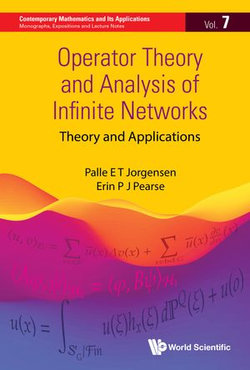This volume considers resistance networks: large graphs which are connected, undirected, and weighted. Such networks provide a discrete model for physical processes in inhomogeneous media, including heat flow through perforated or porous media. These graphs also arise in data science, e.g., considering geometrizations of datasets, statistical inference, or the propagation of memes through social networks. Indeed, network analysis plays a crucial role in many other areas of data science and engineering. In these models, the weights on the edges may be understood as conductances, or as a measure of similarity. Resistance networks also arise in probability, as they correspond to a broad class of Markov chains.
The present volume takes the nonstandard approach of analyzing resistance networks from the point of view of Hilbert space theory, where the inner product is defined in terms of Dirichlet energy. The resulting viewpoint emphasizes orthogonality over convexity and provides new insights into the connections between harmonic functions, operators, and boundary theory. Novel applications to mathematical physics are given, especially in regard to the question of self-adjointness of unbounded operators.
New topics are covered in a host of areas accessible to multiple audiences, at both beginning and more advanced levels. This is accomplished by directly linking diverse applied questions to such key areas of mathematics as functional analysis, operator theory, harmonic analysis, optimization, approximation theory, and probability theory.
Contents:
Preface
About the Authors
Acknowledgments
List of Figures
List of Symbols and Notation
Introduction
Resistance Networks
The Energy Hilbert Space
The Resistance Metric
Schoenberg–von Neumann Construction of the Energy Space Hε
The Laplacian on Hε
The ℓ² Theory of Δ and the Transfer Operator
The Boundary and Boundary Representation
Multiplication Operators on the Energy Space
Symmetric Pairs
The Dissipation Space HD
Probabilistic Interpretations
Spectral Comparisons
Examples and Applications
Lattice Networks
Infinite Trees
Application to Magnetism and Long-Range Order
Future Directions
Appendices:
- Some Functional Analysis
- Some Operator Theories
- Navigation Aids for Operators and Spaces
- A Guide to the Bibliography
Bibliography
Index
Readership: Upper-level undergraduate and graduate students in mathematics, electrical engineering, probability/statistics, theoretical computer science, data science, physics, and econometrics, who would like to get a deeper understanding of large network models. It includes students as well specialists from a host of neighboring areas that are different from analysis of large networks but related. Suitable for courses and self-study.
Key Features:
- For the first time, a detailed account of the theory of infinite networks, with numerous illustrations and explicit examples
- The text offers an insight-oriented approach offering immediacy and flexibility
- The topics are presented in a straightforward style, answering questions in the context of compelling examples
- Introducing also more advanced concepts. This approach motivates the more abstract theory via interesting applications
- This book lays the basic foundation for infinite networks and includes numerous applications, making it beneficial to mathematicians as well as to physicists and engineers
- The book includes guides for students and instructors, for classroom use, and for self-study



Share This eBook: